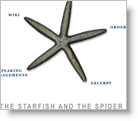
I must confess that org stuff bores me to tears. I didn’t really care for organizational behavior stuff in undergrad or grad school, and chatting about the various types of org charts seems to be a waste of time. I’m sure I’m wrong on all of this and I’m either too dense to really understand the issues or I’m so smart the right answers are just intuitive. Either way, if you told me this was a book about organizational structure I would have changed the channel.
But the authors grabbed my attention from the first sentence. And throughout the book they kept my attention (for me, this was one of those “can’t put it down” books) with story after story, example after example. But if you don’t have time let me sum the idea up with this:
If you lop off a spider’s head, it dies. If you lop off a starfish head (um, it doesn’t have a head…), so if you lop off a starfish arm, it grows back. So to kill it you just cut it in half. Actually, supposedly you will end up with two starfish. Think of how that applies to organizations and companies, and how that plays into competition, growth, etc.
The idea is neat, but the examples are sound – and very supportive. They talk about how the Spanish army defeated the Mexican colonies… and that they tried to destroy the Apache indians but could not. And how this story has too many similarities to MGM trying to destroy Grokster (peer-to-peer music sharing). Did this huge giant destroy P2P sharing? Nope. Does P2P have a “head” to lop off? No.
And this is what the starfish is. It’s the Apache indians. It’s P2P systems like Grokster, Napster, eMule and more. It’s Alcoholics Anonymous. It’s al Quaeda and the Burning Man Festival. It’s the Internet. It’s something that doesn’t have a president or physical presence to destroy, which will only follow with the demise of the organization. It’s something that gets power from being decentralized.
And traditional spider companies don’t understand it, and they don’t understand how to compete against it. But it’s pretty real. MGM said the recording industry lost 25% of their revenues because of the P2P threat (page 13). Mergers have happened because of P2P. And because of Skype, which has billions of subscribers (I have my Skype window open right now and have spent about 2 hours on Skype calls today).
The authors talk about a hybrid company, with characteristics of spider + starfish. The point to eBay, Craigslist and Amazon.com as examples. I’ve watched these companies go from nothing (raise your hand if you remember when Amazon announced they were in the black… and compare that with this quarter’s announced profits!!) to something but didnt’ think about them in this starfish+spider context. Fascinating.
The authors conclude with a list of 10 “New Rules” to compete in this starfish environment. I would list them except the titles alone don’t make sense, and they masterfully draw previous examples back in to support each point.
Can starfish organizations be defeated? Yes. The authors give 3 strategies to defeat a well-decentralized organization. And support each strategy with example.
So I can’t say enough good about this book – it is short enough to read in about a day, it is intriguing and full of information, it has excellent suggestions on how to compete with the different organizations, and even proposes the “sweet spot” that perhaps an org should shoot for. I highly recommend checking it out (but you already figured I’d say that). Thanks to Scott Allen for turning me on to it.

Scott was kind enough to pass on this one to me as well, but I haven’t had the chance to crack it. I’ll definitely do so now. Nice review.
Pete Johnson
HP.com Chief Architect
Work email: pete.johnson@hp.com
Personal email: pete.johnson@nerdguru.net
Personal Blog: https://nerdguru.net